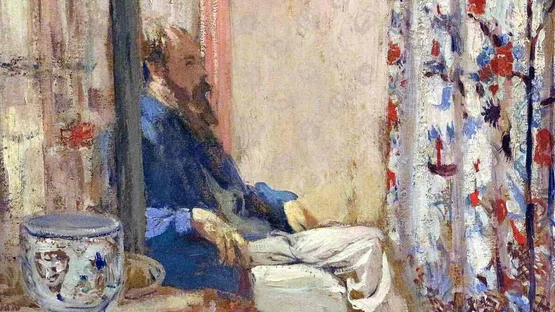
Edouard Vuillard / Jean-Édouard Vuillard
French artist Édouard Vuillard is well known for painting intimate interior scenes dominated by women. He was a printmaker and decorative artist who designed stained glass, plates, panels for decoration of homes, and theatre sets. Vuillard was part of the Nabis group of artists whose members were also Maurice Denis, Paul Sérusier, and Pierre Bonnard. Unlike his contemporaries, his work depicted everyday scenes of bourgeois' private families' lives in homes and gardens. After the Post-Impressionist Nabis group broke up, the artist began painting interiors and landscapes in a more realistic style. Today Vuillard's artworks are part of numerous private and public collections, including the Tate Gallery in London, the Hermitage Museum in St. Petersburg, and the National Gallery of Art in Washington, D.C.
Les Nabis
Born in 1868 in Cuiseaux, France, Jean-Édouard Vuillard fell in love with decorative and intimate objects thanks to his mother, a seamstress. He attended the Lycée Condorcet, where he met some of the members of the future Les Nabis group. With Ker-Xavier Roussel, he studied at Diogène Maillart's studio painting and was later accepted to the prestigious Académie Julian and École des Beaux-Arts. In his early sketchbooks, he studied the works of Michelangelo and 17th-century Dutch painters.
In 1890 together with Denis and Bonnard, he formed the Les Nabis. The group shared a common interest and fascination with Japanese woodblock prints, especially their asymmetrical stylizations. Also, they greatly admired the avant-garde paintings of Paul Gauguin and his use of flattened space and colors. About his art Édouard Vuillard said:
I go on with my work according to my conscience, endeavoring to express what I feel and what I love, and I have no other goal.
Domestic Scenes
Many of Vuillard's paintings depict three of the most important women in his life, his mother, Misia Natanson, and Lucy Hessel, with whom he had an affair that lasted 40 years. The work from the Nabi period is recognizable by flattened space. In the painting Woman Sweeping (1899–1900), the composition is full of rich patterns that stand in contrast to one another. His fellow Nabi artist named this particular style Intimists.
Besides painting, Édouard also created book illustrations, theater stage designs, and posters. The artist was one of the founders of Symbolist theater Aurélien Lugné-Poë’s Théâtre de l’Oeuvre. After the group disbanded, the artist adopted a naturalistic style and began receiving numerous commissions for portrait and decorative works for private homes and public buildings, such as Palais de Chaillot, League of Nations in Geneva, and Théâtre des Champs-Élysées.
Rediscovery of Édouard Vuillard's Work
With the emergence of Futurism and Cubism in the early 20th century, the art world lost interest in Vuillard's intimist sensibility and compositions of quiet domesticity. Vuillard, who throughout his career never abandoned his signature style, was seen by many as too conservative. His early work was more respected than later until the second half of the 20th century when Vuillard's mastery was once again recognized as worthy of recognition. Édouard Vuillard passed away in 1940 in France.
Featured image: Edouard Vuillard - Il pittore Ker-Xavier Roussel e sua figlia, (detail) 1903. Captions, via Creative Commons
Can We Help?
Have a question or a technical issue? Want to learn more about our services to art dealers? Let us know and you'll hear from us within the next 24 hours.
